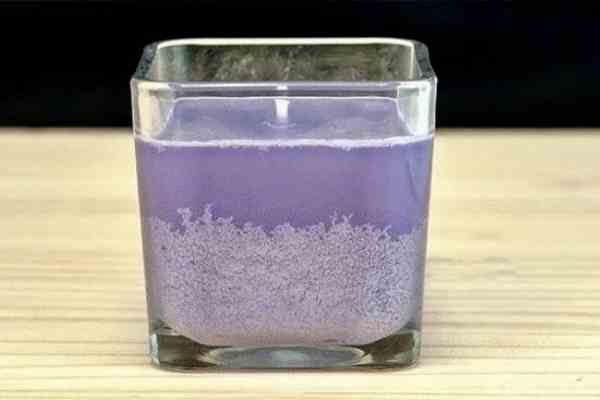Have you ever tried to make soy wax candles yourself? Sometimes they will turn out perfect. Other times, after leaving them to cool, they can look frosted. It is a frustrating stage of candle making to be stuck. With this in mind, let me show you why your wax candles are frosting and what you can do to try and stop it or at least limit it.

What is candle frosting?
Candle frosts are white crystal-like formations on the outside of a candle. This is a natural reaction that is common to soy wax candles and other types of vegetable waxes. Also referred to as blooming, candle frosts appear as a crystalline or whitish-color coating at the top or side of waxes.
At a glance, candle frosting appears bad. On the contrary, frosting does not affect a candle’s burning properties or its scent throw. It is only a matter of aesthetics. In fact, frosting is one sure way to tell that your candle is from an all-natural and pure soy wax and not a harmful blend.
Why do candles frost?
Frosting occurs primarily due to the passage of time, different temperatures, and temperature fluctuations. It follows polymorphism – the crystallization into more than one identical chemical but with distinct forms. Crystal structures continue to form over the course of the life of soy wax. Even if you can’t see the structures, the wax will continue to harden with time.
When soy wax mixed with oil is subject to temperature fluctuations, crystals will inconsistently form in the wax. In other words, the wax tries to go back to its original natural form. To do this, it starts to crystalize.
Apart from soy wax candles, frosting occurs in palm wax and other vegetable waxes. However, paraffin wax has a more stable crystalline structure; hence, there are lesser polymorphism effects. Because of this, soy wax manufacturers sell soy wax blends with additives to prevent frosting. These additives increase performance, stabilize crystal structures, and allow oils to stay in the wax.
How to stop candles frosting – the guide
As I mentioned, frosting is a natural process that really doesn’t have any effect on your candle’s performance. Although candle manufacturers use additives to reduce the polymorphic and unstable nature of the wax to make it friendly, you can try the following to reduce frosting.
Manage the temperature
Cure the wax in a stable environment
Temperature fluctuation is a major culprit of candle frosting. Therefore, to reduce the chances of a frost ever occurring, cure it in a stable environment.
Whenever the temperature changes, the wax re-crystalizes – the molten wax will harden, and crystal formations on the top will change. Let your candle cure at a stable temperature before pouring.
Preheat candle container
Preheating the candle container will reduce the chances of wax adhesion to the sides of the container. You can use a heat gun to warm the container before pouring each candle. It will also prevent other issues like wet spots.
Pour the wax at a low temperature
Reduce crystal formation by pouring the wax at a low temperature. This helps to increase adhesion; hence, reducing crystal formation. After preheating the container, you can pour at a lower temperature. Pour the soy wax at 95-110 degrees for a nice result.
Cool the candle at room temperature
Keep your candles away from drafts, open windows, fan, and turn the air conditioner off to cool. Let the candles cool at room temperature or above. Since temperature fluctuation or a drop in temperature is responsible for frosting, you will reduce the severity or speed of frosting if you cool the candle under a controlled temperature.
Stir the candle less vigorously
Stir the candle wax gently to prevent creating bubbles in the wax. When you stir forcefully with a large spoon, the force will create air that will cause bubbles. However, gently stirring will reduce agitation and bubbles in the wax.
Use wire racks for cooling
Wire racks encourage even cooling. As I mentioned earlier, a stable temperature minimizes the chances of frosting. When you set your candles on a wire rack to cool, they will cool evenly and significantly eliminate the chances of frosting or wet spots.
Use your candle after curing
Apart from temperature, time is the other culprit in frosting candles. When given enough time, natural waxes will eventually frost. As a result, it is best to use or sell the candles as quickly as possible after curing.
For more information on curing waxes have a look at this guide that I wrote.
Use candle wax additives
Candle additives can prevent frosting, improve hot throw, and reduce color fade. You can buy soy wax with additives or buy additives yourself and use them.
Use the correct ratio of fragrance oil to wax
Getting the right amount of fragrance oil into your candle wax is a crucial step. To little and your candle will have no scent. To much fragrance oil and your candle can frost, split and crack. To work out the perfect amount of fragrance oil for your wax and container size try using my fragrance oil and wax calculator.
How to fix a frosted candle?
If it is too late to prevent frosting on your candle then there are still ways that you can fix a candle that has frosted. Read on below to find out how to fix a candle with frosting.
Hide the frost
The simplest way to fix a frosting is to limit its visibility. The frosting is less obvious in soy waxes in an opaque container or soy wax with no color. If you leave the natural color of the wax, the colorless blend won’t make the frosting visible. But if you intend to color your wax, all the same, use an opaque or darker container.
Use a heat gun or blow dryer
If your candle frosts at the top, remelt the top layer with a heat gun or a blow dryer. Then, let it cool again. This usually fixes the frosting problem. • Slowly heat the frosting areas to melt the layer on top. This releases air trapped inside. • Provide consistent heat to the entire candle to ensure even cooling and prevent more frosting opportunities.
Conclusion
Direct sunlight, temperature fluctuations, and time are responsible for frosting. Even with all preventing techniques, it is ultimately impossible to prevent frosting. Why? It is a beautiful and natural feature of soy wax. As a result, you can’t completely control frosting.
Most soy candle enthusiasts anticipate frosting. This is one sure way to know that you are using 100% pure soy wax and will have all the benefits it offers. But if you don’t want to see it, take the steps above to minimize the chances of candle frosting.
- Can You Put Perfume In A Humidifier? (Read First) - September 17, 2022
- Can You Put Essential Oil In A Steam Mop? (Safety Advice) - September 17, 2022
- How To Make Lavender Oil At Home ( Candles And Diffusers) - September 9, 2022
